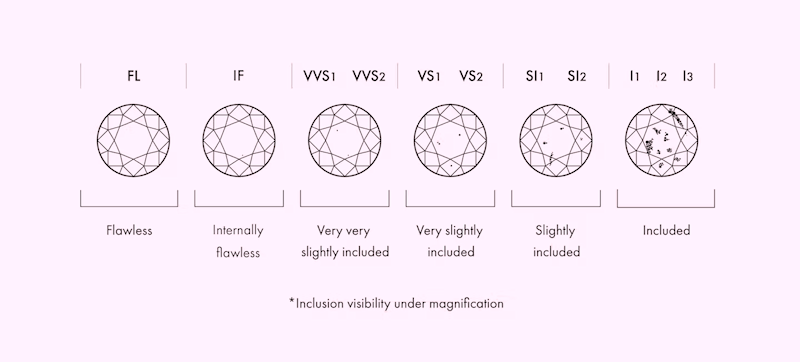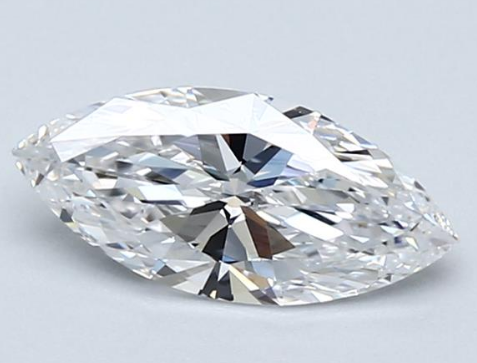
Learn About VVS2 Grading Clarity
VVS2 is a diamond clarity grading that indicates a very, very slightly included diamond. This means that any inclusions (internal characteristics or flaws) present in the diamond are difficult to see even under 10x magnification. VVS2 diamonds are considered to be of high clarity and have a higher value than diamonds with more visible inclusions.
In diamond grading, the clarity of a diamond is determined by the amount, size, position, and nature of inclusions within the diamond. Inclusions can be internal, such as tiny crystals or fractures, or external, such as scratches or nicks on the diamond’s surface. Inclusions can affect the diamond’s appearance, durability, and value, so it is important to carefully evaluate them when grading a diamond.
VVS2 Diamonds Are Considered Very Rare
The VVS2 clarity grading is part of the VVS (Very, Very Slightly Included) category, which is the second highest clarity grade after the top-grade IF (Internally Flawless) category. VVS1 and VVS2 diamonds are considered to be virtually flawless, with inclusions that are extremely difficult to see even under close inspection with a 10x magnification loupe. In general, VVS1 diamonds have even fewer and smaller inclusions than VVS2 diamonds, and are therefore considered to be of higher clarity and value.
To give you an idea of what to expect with a VVS2 diamond, the inclusions in a VVS2 diamond may be visible only under specific lighting conditions and when viewed at a certain angle. They may appear as very small crystals, clouds, or feathers, and may be located near the diamond’s surface or hidden deep within the stone. However, these inclusions are typically not visible to the naked eye, and the diamond will have a high level of clarity and sparkle.
They Are Beautiful Diamonds
In conclusion, a VVS2 clarity grading indicates that a diamond has very, very slightly included inclusions that are difficult to see even under 10x magnification. This is a high clarity grade and indicates that the diamond is of good quality and value.
An example of a diamond under the clarity category VVS2:

The Differences Between VVS1 And VVS2
The main difference between VVS1 and VVS2 diamonds is their level of clarity. VVS1 diamonds are considered to be of very high quality in terms of clarity, with very few inclusions that are difficult for even a trained gemologist to see under 10x magnification. VVS2 diamonds, on the other hand, have slightly more inclusions that are visible under 10x magnification, but are still considered to be of high quality.
Another difference between VVS1 and VVS2 diamonds is their rarity. Because VVS1 diamonds have such high clarity, they are less common than VVS2 diamonds, which means that they may be more sought after and command a higher price on the market.
In terms of appearance, VVS1 and VVS2 diamonds may appear very similar to the naked eye. Both types of diamonds have a high level of sparkle and brilliance, and will have a clean, pure appearance. However, a trained gemologist may be able to see the differences in clarity under magnification.
In terms of durability, VVS1 diamonds may be slightly more durable than VVS2 diamonds, as they have fewer inclusions that can act as points of weakness. However, both VVS1 and VVS2 diamonds are generally considered to be very durable, and are less likely to be damaged than lower quality diamonds.
Overall, the main differences between VVS1 and VVS2 diamonds are their level of clarity, rarity, and potential durability. While both types of diamonds are considered to be of high quality, VVS1 diamonds are the rarest and most highly prized in terms of clarity of the two.
Tips Regarding VVS2 Diamonds
- Consider the price. VVS2 diamonds are high quality and can be expensive, so it is important to have a budget in mind and to compare prices from different vendors to ensure that you are getting the best value for your money. VVS2 diamonds are typically less expensive than VVS1 diamonds, which are considered to be the highest quality in terms of clarity. However, they may still be more expensive than lower quality diamonds, such as VS1 or SI1.
- Look for certification. In order for a diamond to be considered VVS2, it must be certified by a reputable independent laboratory, such as the Gemological Institute of America (GIA) or the International Gemological Institute (IGI). It is important to look for this certification when purchasing a VVS2 diamond, as it provides assurance that the diamond has been thoroughly evaluated and meets high standards of clarity.
- Consider the cut. The cut of a diamond refers to its proportions and symmetry, which can affect the diamond’s sparkle and brilliance. VVS2 diamonds should have a well-cut, symmetrical shape to maximize their optical properties and create a stunning visual effect.
- Consider the setting. The setting of a diamond can also affect its appearance and overall value. A well-made setting can enhance the beauty of a VVS2 diamond, while a poorly made setting can detract from it. It is important to carefully consider the setting and choose one that will complement the diamond and enhance its overall beauty.